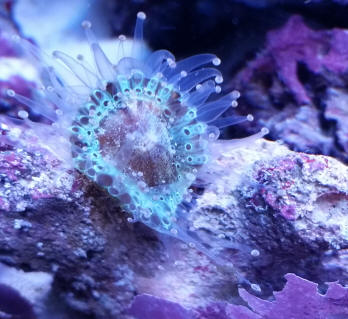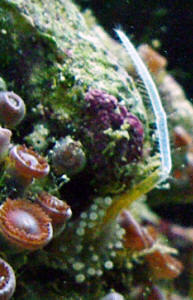|
FAQs about Pseudocorynactis Corallimorphs
Related Articles: Corallimorpharians, Cnidarians, Water Flow, How Much
is Enough,
Related FAQs: Mushroom ID 1, Mushroom ID 2, Mushroom ID 3, Mushroom ID 4, Mushroom ID 5, Mushroom ID 6,
Mushroom ID 7, Mushroom ID 8,
Mushroom ID 9,
& Corallimorphs, Mushrooms 2, Mushrooms 3, Mushrooms 4, Mushroom Behavior, Mushroom Compatibility, Mushroom Selection, Mushroom Systems, Mushroom Feeding, Mushroom Health, Mushroom Reproduction,
Stinging-celled Animals,
|
|
Pseudocorynactis questions 1/3/19
Hello Crew! Hope all is well with you and have a happy New Year!
<And you Joanne>
Got a few questions for you today, as always I appreciate your advice
and input.
<Sure>
I recently had two tiny polyps pop up on some live rock rubble I got
from the bin at my LFS. It is ultimately destined for the sump but I
always like to give new rock a chance in the light to see if anything
interesting pops up. Anyway, there were these two tiny white specs,
honestly at first I thought they were a couple of tiny pineapple
sponges. But over a few weeks they slowly got bigger, enough that I
could make a tentative id.
I'm assuming these little guys are NPS, since they were probably in that
non-lighted bin for some time. As I said, at first they were dead white
in color, but now that the larger of the two has grown a little I can
start to see some orangey color at the center. The balls at the end of
the tentacles are still white. I have noticed that they are only active
during the daytime, and after lights-out they close up.
<Sounds like this Shroom>
This behavior, along with the fact that the live rock at the LFS is all
Indo-Pacific origin, leads me to believe that that is the most likely
source for these little guys. Do you agree? There is of course a very
very remote chance that they hitchhiked in on a gorgonian from the
Caribbean but not very likely IMO.
<Could be>
Second question, do / can these critters change color over time? I know
the Indo-Pac Pseudocorynactis can be very colorful but so far I have
only seen that little hint of orange. Maybe that is just because they
are so tiny? Do you think they may become more colorful as they grow
larger?
<Can/may change to be more or less colorful... depending on conditions,
nutrition>
I've heard they can be dangerous to fish, and have also heard that they
are likely NOT dangerous to fish, LOL. What are your views on that?
<Non-dangerous>
Right now they are too tiny to hurt anything so I'll just keep an eye on
them as they grow. If they grow very large or seem to be becoming
dangerous to my fish, I'll set them up in their own little nano
aquarium.
As always, thanks so much for your helpful words!
*Thanks,*
*Joanne White*
<Cheers, Bob Fenner, diving down in Roatan, looking for this genus, but
thus far just Ricordea florida>
|
Type of Corallimorph 3/7/16
Hi crew, No question here! I just wanted to submit a pic of one of my white
ball Corallimorphs.
<6.2 megs... in Roatan>
I think they look awesome and are great additions to reef aquarium. I've had
3 in my tank for almost 5 yrs now. I spot feed every once and a while. The
biggest one can open to over 2" full tentacle extension (at night). I know
that there are smaller types that can spread like Aiptasia and might become
a nuisance but this particular type I've had for years now with no issue.
Happy Reefing, Cheers!
<And you, B>
|
 |
|
Weird Pseudocorynactis sp. behavior
9/5/09
Hi folks,
<Roxanne>
I've recently had these Pseudocorynactis pop up all over the
rocks in my reef tank. But today, I noticed a new and odd
behavior.
<I'll say!>
There is a long two toned "stalk" from the center of
the anemone.
<Corallimorph>
As you can see from the attached picture, the white tip seems to
have several "hairs" all along it to the end.
<I see it/this...>
Have you ever seen anything like this? Any ideas what it may be
doing?
<I have not and don't... the tube portion looks like a
leathery tubiculous worm... the "worm" itself? Bizarre.
Am going to post on WWM in the hope someone will recognize what
this is and chime in. Thank you for sending this along. Bob
Fenner>
Thanks,
Roxanne
|
 |
|
Re: Weird Pseudocorynactis sp. behavior--
9/5/09
Just a note........not sure if it has anything to do with this,
but I have a very large, healthy feather duster in the tank which
was "smoking" but don't recall if it was before or
after this event. If memory serves, it was after.
Also, the "worm" comes from the location of the mouth
of the Corallimorph. In fact, it appears to *be* the mouth.
<Thank you for this further input... Is (to me!) for sure a
mystery! Let's wait, hope not so to someone else. Cheers (and
biers), BobF>
Re: oh, and the mystery marine object--
9/5/09
Hi Bob,
Under the topic "Weird Pseudocorynactis sp. behavior
9/5/09" I do believe that thing is merely a crustacean limb
attached to a sticky Cnidarian.
Whether a moult or otherwise cannot say. The segmentation and the
setae along the edge seem pretty consistent with an arthropod
limb.
Cheers, Neale
<Ahh! A very good "guess" I believe... Was wondering
what the object reminded me of. Will forward to the querior,
accumulate. BobF>
|
| Ball Corallimorph - Pseudocorynactis
11/17/03 I have two questions for the knowledgeable crew of WWM
- if you can spare the time :) <ready and willing!> 1. A
while back I found this cutesy little hitchhiker on my live rock
(photo included). Can you tell what it is? The only possibility I
came up with is a Corallimorpharian, Pseudocorynactis sp. (although
in the pictures the colors are different). <you are exactly
correct as best I can tell my friend> This worries me a little,
because Julian Sprung says in his book that the Indo-Pacific
Pseudocorynactis will grow big and eat small fishes/mobile inverts
(!) <understood... but very unlikely/uncommon in my opinion.
Where did you get your live rock from? This genus is found and
smaller in the Atlantic too/Caribbean> I like the little fellow,
but if he's shaping to be a fish eater, then I'd better nip
him in the bud, so to speak. So it would be helpful if
you could confirm - or refute - my identification. <unless fed
well/heavily... I don't see this creature growing too large for
you. Enjoy it> 2. I know you guys are against mixing different
groups of corals (SPS, LPS, Zoanthids etc) <very much so> -
and it makes perfect sense when we're talking, say, about
tabletop Acropora from the reef front being housed together with
mushroom corals that naturally live in calmer, deeper waters.
<exactly> But how about species from the same habitat? Say,
Montipora digitata and soft corals - all lagoon dwellers?
Wouldn't it be natural to put them together? <indeed... and
yes, I am more comfortable with that (although we still have to
reckon with more allelopathy because we do not have the dilution of
the expanse of the sea at our disposal). I am asking because I have
softies at the moment (the beginner's obvious choice), but I
would love to try Montipora one day - and then, barring a total
re-haul of the tank, it would find itself among soft corals... What
is your opinion of that combination? <I sincerely think the
Montiporas are a fine choice here for many reasons.> All the
best Anka from Poland (a dedicated fan of your great site :))
<with kind regards, Anthony> |
|

|
|
|

